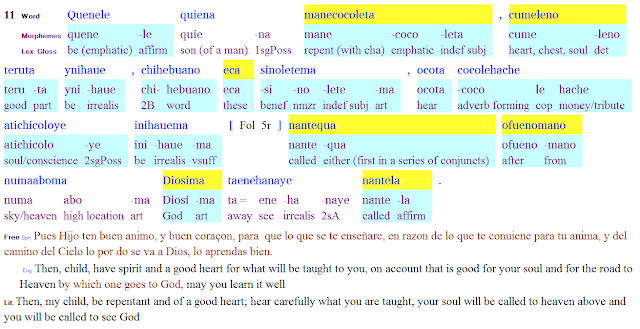The agreement system of Timucua is surprisingly complex. In my SSILA 2016 paper, I outline basic properties of the paradigms involved. To quote part of that:
A problematic detail for that paper is the distribution of the two forms of 2nd person A agreement. For the singular, these are -naye ~ -naie and -chi. For the plural, they are -naqe and -chica.The A and B agreement affixes appear at different places in the structure of the verb, and the 1st and 2nd plural B agreement are composed of a prefix and a suffix. The 2nd person A suffixes can appear in two positions, which I call the general and the restricted postion (as discussed in more detail in 3.1.3). B prefixes also appear in two possible positions -- one for core arguments and one for applied objects. Agreement for applied objects precedes the locative/instrumental applicative prefix na-, while core agreement follows the applicative. Thus the pattern follows a template like the following.AgrBAppliedapplic=AgrB-verb -applic-AgrB-pres-AgrAgeneral-past-AgrArestricted{complementizer/illoc force}The two paradigms are shown below:
A paradigm B paradigm 1sg -la~-le ni- 2sg -naye (general) ~ -chi- (restricted contexts) chi- 3sg -- -- 1pl -nica ni-...-bo 2pl -naqe (general) ~ -chica (restricted contexts) chi-...-bo 3pl -mo ~ -ma -bo Table 4 Present paradigmIf both arguments of the verb are local (1st or 2nd person) then the subject shows A agreement and the object shows B agreement.
The facts are more complicated than my conference paper had time to explore. A particularly puzzling fact is the relative order of the 2sA prefix and the future suffix -he ~ -ha. The facts seem to show that in statements, the order is
V-future-2sA
while in questions, the order is
V-2sA-future
Examples that support this generalization. First the questions:
 | |
| 1612 Cat, f012r |
Next come the statements
 |
| "...know that if you eat from the tree of life standing, this tree of life of good and evil deeds which you must not eat from, you will die a death without delay" |
The data for examples in the past is less robust -- there are plenty of 2nd person past questions ("did you V...?), but not many clear cases of 2nd person past statements ("You V-ed"). Nevertheless, it seems that the same pattern is found.
Note the sequence V-bi-naye in the first lines of these examples. (It seems that in the "have you counseled her" example, the verb that shows interrogative morphology is the last one.)
 |
| Because you refused my word, this was a very great sin, and so all the food will be earned with work and you will sweat and be cold. |
The position of 2sA after the past marker is seen in the last example.
How can the template be adapted to reflect this difference between statements and questions?
The correct generalizations seem to be
- the future and past are in the same slot and
- 2sA agreement precedes the future/past in a question, using the restricted form -chi, but
- 2sA agreement follows the future/past in a statement, using the general from -naye.
These are not very easy facts to accommodate into the theory. Perhaps questions require non-final agreement? But what kind of strange requirement is that?



No comments:
Post a Comment